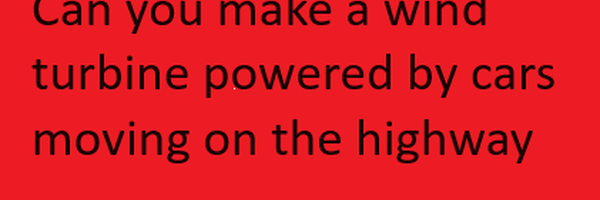Can you generate electricity using high speed winds from cars passing by on the highway?
Grade 7
Presentation
Problem
For the past few decades, there has been a rise in the things that are damaging the Earth. They have affected all the natural phenomena and ecosystems. With this rate, the upcoming generations will suffer the most from it. Energy is one of the main resources that support the lifestyle of humans in the current era, but almost 80% of the energy produced today is generated from fossil fuels. Currently, the world is in extreme need of renewable energy sources due to the negative effects of fossil fuels. Also, many researchers have proven that renewable energy sources are way cheaper than the normal methods in terms of production. Many sources around the globe can generate renewable energy. Many researches have shown that Earth has a great capability for wind energy especially along the coastlines.
Method
I have attached a 12v-55v AC motor to an LED to show the electricity that is being generated. Also, this is how it works,
The process of harnessing wind energy to generate electricity is achieved through the use of turbines. The mechanical energy produced by the rotation of these turbines is converted into electrical energy through the copper shaft inside the generator. This electrical energy is then utilized to power an LED, providing light. The efficacy of this process is dependent on the efficiency of the wind turbines and the generator.
Research
1. How much electricity does an average household need and how can Vertical turbines help?
In a day, we use about 20 kilowatt hours of energy. In a week, we use more than 150 kilowatt hours. And in a month, about 600 kilowatt hours are used. We use mostly fossil fuels to make this electricity. One solution is using Vertical turbines. One vertical turbine on the road has the potential to generate enough energy to power more than 900 homes in a month! This is possible because it uses wind, a renewable and sustainable resource.
2. Invention
Georges Darrieus invented the world's first lift-based vertical axis wind turbine in the 1920s. The turbine has troponin curved blades shaped like an egg beater, known as a full-Darrieus or Φ-configuration Darrieus turbine, but commonly referred to as a Darrieus turbine. The turbine’s curved blades attach directly to the vertical torque tube at the top and bottom. This tube rotates and serves as the support structure. The top of the turbine can be held upright by guy cables, or the torque tube can be cantilevered from the base. In contrast, the H-rotor, or giro mill, has straight blades that attach by a cross-arm. The H-rotor can drive a generator at either the tower's top or ground level, using a shaft placed inside the tower.
Data
1. Energy conservation
The process of harnessing wind energy to generate electricity is achieved through the use of turbines. The mechanical energy produced by the rotation of these turbines is converted into electrical energy through the copper shaft inside the generator. This electrical energy is then utilized to power an LED, providing light. The efficacy of this process is dependent on the efficiency of the wind turbines and the generator.
2. How much electricity does an average household need and how can Vertical turbines help?
In a day, we use about 20 kilowatt hours of energy. In a week, we use more than 150 kilowatt hours. And in a month, about 600 kilowatt hours are used. We use mostly fossil fuels to make this electricity. One solution is using Vertical turbines. One vertical turbine on the road has the potential to generate enough energy to power more than 900 homes in a month! This is possible because it uses wind, a renewable and sustainable resource.
Conclusion
I have concluded that VWT is amazing and should be on the roads already. I also think that unlimited energy is very important and I know for a fact that the wind will never run out. Overall, This concept would help us and future generations.
Citations
Acknowledgement
My teacher, my parents, and scientific supervisors
https://www.sciencedirect.com/topics/engineering/vertical-axis-wind-turbine
https://www.sciencedirect.com/science/article/pii/S1364032118308153
https://www.usgs.gov/faqs/how-many-homes-can-average-wind-turbine-power

